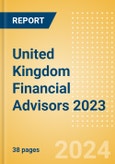The UK’s financial advice market is undergoing a period of change and evolution. The composition of the market is changing amid an ongoing wave of consolidation thanks to ready sellers and willing buyers. Single advisor firms still dominate the market, but the average number of advisors per firm keeps ticking up, indicating a shift towards medium-sized and large outfits. Financial advisors play an important role in serving retired individuals and those approaching retirement. However, the enduring challenge lies in closing the advice gap, as less than 10% of consumers have accessed regulated financial advice.
Scope
- The number of financial advice firms fell by 1.1% in 2022, with 56 fewer firms in the market compared to 2021. Conversely, the number of financial advisors increased by 1.4%.
- 2023 saw a record number of acquisitions in the advice sector, with over 102 deals recorded. The key drivers for business sales are retirement and the support of a large business.
- 24.8% of investors stated that financial advisors were their preferred channel for arranging investments. 33% of these investors were aged over 65.
- Fewer investors are considering environmental, social, and governance (ESG) factors when investing compared to 2021-22. However, the introduction of new Sustainability Disclosure Requirements should boost confidence in the industry.
Reasons to Buy
- Understand the latest data on the size and composition of the UK financial advice market
- Find out about the latest M&A deals in the consolidating financial advice space
- Learn who uses financial advisors and what their motivations are for doing so
- Discover the key trends and themes affecting the financial advice industry
- Understand the current regulatory challenges that financial advisors are facing
- Learn more about how advisors can prepare for The Great Wealth Transfer
- Uncover the opportunities offered by ESG investing and the productivity gains of generative AI
Table of Contents
Companies Mentioned (Partial List)
A selection of companies mentioned in this report includes, but is not limited to:
- Perspective Financial Group
- Fairstone
- Wren Sterling
- and Skerritts
- Lync Wealth Management
- Sheafmoor Money Management
- North Financial Management
- Liberate Wealth
- Soderberg & Partners
- Canaccord Genuity








